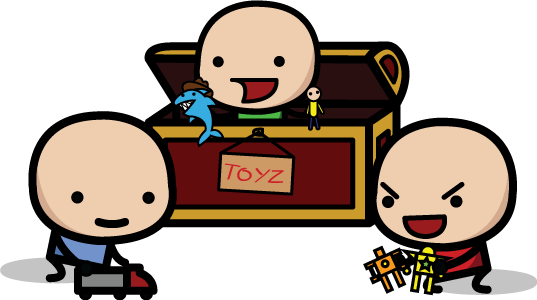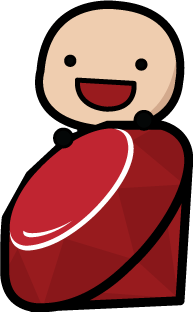Collections
In order to store data, we use collections. There are two types of ways we store our data collections. One is called an Array, the other is called a Hash. You can think about a collection of data like a trunk of toys. Let’s start with the Array toy chest first.

Arrays
Arrays are ordered, indexed collections of data that can have various types. An ordered collection means that it is “in order”. When you line up with your classmates at school in a lunch line, you are a collection of kids in an ordered line. Arrays are kind of like that. You can order the line of kids in many different ways. You could order from tallest to shortest. You could line up in oldest to youngest, or you could line up in shortest hair to longest hair. No matter which way you lined up the kids, you’d still be in some kind of order. In code, you’d be in an Array.
Let’s say there was a line of kids: Adam, Billy, Molly and Sally. This line of kids is in alphabetical order, with Adam in front, followed by Billy, Molly and Sally. That means that Adam is number 1, Billy is number 2, Molly is number 3 and Sally is number 4. These are four kids in an ordered line. If we were to write this as an array, it would look like this:
["Adam", "Billy", "Molly", "Sally"]
Arrays are noted using square brackets, with elements separated by a comma. So an array is in order, and it is also indexed. When a collection is indexed, it means that each item has a specific number that relates to its order in line. The tricky part to remember is that computers start their index at zero. This means that Adam’s index is 0, Billy is 1, Molly is 2 and Sally is 3.
One way to think about indexes is distance. Adam is first in the array, so he is zero units away from himself. Billy is next, only 1 unit away from Adam. Molly is 2 units away, and Sally is 3 units away from Adam. You could also think of array indexes like a number line, which also starts at zero.
Here’s what our array looks like with its index.
kids_array = ["Adam", "Billy", "Molly", "Sally"]
# kids_array index => [0,1,2,3]
If we want the first element in our ordered array, we look it up by the first index. The first index in any array is zero. We can find an element by its index using the [ ] method.
kids_array[0]
=> "Adam"
You can think of the brackets like big monkey paws, they clamp down on both sides of the element (whatever the object) and hold it. If you type kids_array[0] you are asking Ruby to get the first spot. In this case, Ruby would tell you that Adam is at index zero.
We can also use the [ ] method to add or change an element in our array. For example, if Sally left to another school and Terry replaced her spot, we could remove Sally and replace her with Terry by using the [ ] method on the correct index number.
kids_array = ["Adam", "Billy", "Molly", "Sally"]
kids_array[3] = "Terry"
kids_array
=> ["Adam", "Billy", "Molly", "Terry"]
We can even add a new member to our array, like so.
kids_array[4] = "Zoe"
kids_array
=> ["Adam", "Billy", "Molly", "Terry", "Zoe"]
Arrays can contain numbers, strings and even other arrays!
number_array = [1,2,3,4,5]
string_array = ["Frank", "Suzy", "Doug", "Jane"]
mixed_array = [number_array, "a string", 13]
If we had an array inside another array, we can use the square brackets in a similar way to access our data. In the example below, in order to grab the number 3, we use square brackets to access the first element in our array (which is another array). We then use another bracket to access the number three, the second element in that array.
lots_of_arrays = [[1,2],"string","test"]
lots_of_arrays[0][1]
=> 2
Ruby gives us some cool methods to call on arrays, like sort. When we call the sort method on our string_array, Ruby sorts our array alphabetically. In Ruby, whenever we use the sort method, the computer understands we want to see the entire array alphabetized.
string_array.sort
=> ["Doug", "Frank", "Jane", "Suzy"]
However, unless we call sort! on the array, the order will not change permanently and our array will stay in its original state. When we ask to sort without an exclamation mark, only the result is sorted (not the actual array). When we call sort! with the exclamation mark, the actual array is sorted in the new alphabetized order.
string_array
=> ["Frank", "Suzy", "Doug", "Jane"]
string_array.sort!
=> ["Doug", "Frank", "Jane", "Suzy"]
Before we get into more examples about arrays, it’s important to mention one of Ruby’s widely used array methods–the shovel. The shovel is written with two less-than symbols << that are used to insert items to the end of an array. Let’s take the example above and add Bill to our string array.
string_array
=> ["Doug", "Frank", "Jane", "Suzy"]
string_array << "Bill"
=> ["Doug", "Frank", "Jane", "Suzy", "Bill"]
We could have added Bill with the push method as well.
string_array.push("Bill")
=> ["Doug", "Frank", "Jane", "Suzy", "Bill"]
The shovel method is favored by Rubyists and it’s good to know how it works. More examples on arrays below.
Practice
1) Put the following kids in an array. Joe, Sally, Tom,
Mary, Doug. Now sort them alphabetically using a standard
Ruby method. What's the resulting array?
2) With your kid_array from question 1, separate the boys
and girls into their own arrays. Then put your two new
arrays into one array called "group". What is the least
amount of lines required to write this code?
3) Now you should have one "group" array with two arrays
nested inside. How might we reverse the order of each
array?
Hint: Ruby methods tend to be named by what they do.
4) Our class group has added one student, Tiffany.
Add her to the girls list in our group array. What does
our array look like now?
5) Imagine our list of boys and girls is much larger than
just three. If each class can only have an equal number of
boys and girls, how might a teacher ensure her lists are
equal? Hint: You can use the count method to count the
number of elements in an array.
Hash
The next type of collection in Ruby is the Hash. A hash is an unordered list of key value pairs. A hash is more like a messy room than an array, which is very organized. With a hash, our list of items come in pairs, placed in any order.
In hash collections, we use curly brackets { } wrapped around pairs of information separated by a comma, { "like" => "this" }. The item to the left of the arrow => is the key and its value is the element on the right.
Hashes are extremely useful when we have multiple numbers of similar items in a list. For example, if you used a hash to organize your toy chest, it might look something like this:
toy_chest = {
"sea_monkeys" => 12,
"dolls" => 5,
"legos" => 514
}
Each of these items is located in our toy chest, and the number of them is represented in the hash. So we have three keys (sea_monkeys, dolls and legos) with their corresponding values (12, 5 and 514). To access information in this hash, we can use brackets like we did for arrays.
toy_chest["sea_monkeys"]
=> 12
toy_chest["dolls"]
=> 5
toy_chest["legos"]
=> 514
To add an item to our toy chest hash, we can simply use brackets in a similar way that we did above to retrieve information.
toy_chest["toy_cars"] = 7
=> 7
toy_chest
=> {"sea_monkeys" => 12, "dolls" => 5, "legos" => 514,
"toy_cars" => 7}
By writing “toy_cars” in brackets next to toy_chest, we’ve actually called a method on our hash, giving it a new key value pair of "toy_cars" => 7. To remove an element, we can call the delete method. Don’t worry too much about methods right now, we just want to show you how easy it is to handle data in your array or hash collections.
toy_chest.delete("sea_monkeys")
=> 12
toy_chest
=> {"dolls" => 5, "legos" => 514, "toy_cars" => 7}
There are several other ways to add, remove and manipulate data in our hash collection. But before we understand these methods, we need to learn about methods in general. Check out some examples of using a Hash below, and then, onward to the next chapter!
Practice
1) Create a hash for the Wizard’s magic bag. Inside the
bag, we’ll put 3 frogs, 5 herbs, and 10 scrolls. Assign
the hash to the variable "bag".
What does your hash look like?
2) Remember, hashes consist of key value pairs of any
data, not just numbers. Let’s add a wizard’s spell and
its result (which the wizard can never seem to remember).
Add a spell to our wizard’s bag with the key: "shazam"
and the value "turns subject into a frog".
Now what's in our bag?
3) Our wizard has a change of heart and decides he never
wants to turn anyone into a frog. How can we remove the
spell "shazam" from our wizard bag?
4) Our wizard has recently acquired 3 different types of
potions. 4 orange potions, 5 blue potions and 7 red
potions. How might we add another hash of potions to our
bag?
Hint: remember that we can have collections within a
collection.
5) Now that our bag has four keys (frogs, herbs, scrolls
and potions), we can use these keys to access our data.
In order to make a new spell, our wizard needs 2 frogs,
3 herbs, 1 scroll and 2 blue potions. How can we remove
these items from our hash?
Hint: We can set the value of a key item to itself, minus
how many items removed.
